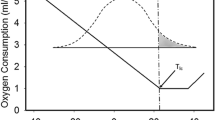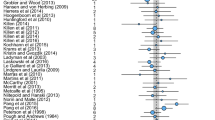Abstract
Mammalian basal metabolic rates (BMR) increase with body mass, whichs explains approximately 95% of the variation in BMR. However, at a given mass, there remains a large amount of variation in BMR. While many researchers suggest that the overall scaling of BMR with body mass is due to physiological constraints, variation at a given body mass may provide clues as to how selection acts on BMR. Here, we examine this variation in BMR in a broad sample of mammals and we test the hypothesis that, across mammals, body composition explains differences in BMR at a given body mass. Variation in BMR is strongly correlated with variation in muscle mass, and both of these variables are correlated with latitude and ambient temperature. These results suggest that selection alters BMR in response to thermoregulatory pressures, and that selection uses muscle mass as a means to generate this variation.



Similar content being viewed by others
References
Artacho P, Nespolo RF (2009) Natural selection reduces energy metabolism in the garden snail, Helix aspersa (Cornu aspersum). Evolution 63:1044–1050
Blackmer AL, Mauck RA, Ackerman JT, Huntington CE, Nevitt GA, Williams JB (2005) Exploring individual quality: basal metabolic rate and reproductive performance in storm-petrels. Behav Ecol 16:906–913
Blanco RE, Gambini R (2007) Maximum running speed limitations on terrestrial mammals: a theoretical approach. J Biomech 40:2517–2522
Bozinovic F, Muñoz JLP, Cruz-Neto AP (2007) Intraspecific variability in the basal metabolic rate: testing the food habits hypothesis. Physiol Biochem Zool 80:452–460
Bozinovic F, Rojas JM, Broitman BR, Vásquez RA (2009) Basal metabolism is correlated with habitat productivity among populations of degus (Octodon degus). Comp Biochem Physiol A 152:560–564
Brown JH, Gillooly JF, Allen AP, Savage VM, West GB (2004) Toward a metabolic theory of ecology. Ecology 85:1771–1789
Calder WA (1984) Size, function, and life history. Harvard University Press, Cambridge
Careau V, Morand-Ferron J, Thomas D (2007) Basal metabolic rate of canidae from hot deserts to cold arctic climates. J Mammal 88:394–400
Chown SL, Addo-Bediako A, Gaston KJ (2003) Physiological diversity: listening to the large-scale signal. Funct Ecol 17:568–572
Crile G, Quiring D (1940) A record of the body weight and certain organ and glad weights of 3690 animals. Ohio J Sci 40:219–259
Daan S, Masman D, Groenewold A (1990) Avian basal metabolic rates: their association with body composition and energy expenditure. Am J Physiol 259:R333–R340
Darveau CA, Suarez RK, Andrews RD, Hochachka PW (2002) Allometric cascade as a unifying principle of body mass effects on metabolism. Nature 417:166–170
Eisentraut M (1961) Beobachtugen uber den warmehaushalt bei halbaffen. Biol Zbl 80:319–325
Field J, Belding HS, Martin AW (1939) An analysis of the relation between basal metabolism and summated tissue respiration in the rat. I. The post-pubertal albino rat. J Cell Comp Physiol 14:143–157
Garland T Jr, Harvey PH, Ives AR (1992) Procedures for the analysis of comparative data using phylogenetically independent contrasts. Syst Biol 41:18–32
Grafen A (1989) The phylogenetic regression. Philos Trans R Soc Lond B Biol Sci 326:119–157
Grand TI (1977) Body weight: its relation to tissue composition, segment distribution, and motor function. I. Interspecific comparisons. Am J Phys Anthropol 47:211–240
Grand TI (1983) Body-weight—its relationship to tissue composition, segmental distribution of mass, and motor function. 3. The didelphidae of French-Guyana. Aust J Zool 31:299–312
Grand TI (1990) Body composition and the evolution of the Macropodidae (Potorous, Dendrolagus and Macropus). Anat Embryol 182:85–92
Grand TI, Barboza F (2001) Anatomy and development of the koala, Phascolarctes cinereus: an evolutionary perspective on the superfamily Vombatoidea. Anat Embryol 203:211–223
Hodkinson ID (2003) Metabolic cold adaptation in arthropods: a smaller-scale perspective. Funct Ecol 17:562–567
Holliday MA (1986) Body composition and energy needs during growth. In: Falkner P, Tanner JM (eds) Human growth: a comprehensive treatise. Plenum Press, New York, pp 101–117
Ihaka R, Gentleman R (1996) R: a language for data analysis and graphics. J Comput Graph Stat 5:299–314
Isler K, van Schaik CP (2006) Metabolic costs of brain size evolution. Biol Lett 2:557–560
Jackson DM, Trayhurn P, Speakman JR (2001) Associations between energetics and over-winter survival in the short-tailed field vole Microtus agrestis. J Anim Ecol 70:633–640
Kleiber M (1932) Body size and metabolism. Hilgardia 6:315–353
Konarzewski M, Diamond J (1995) Evolution of basal metabolic rate and organ masses in laboratory mice. Evolution 49:1239–1248
Kozłowski J, Konarzewski M (2004) Is West, Brown and Enquist’s model of allometric scaling mathematically correct and biologically relevant? Funct Ecol 18:283–289
Kozłowski J, Konarzewski M, Gawelczyk AT (2003) Intraspecific body size optimization produces intraspecific allometries. In: Blackburn TM, Gaston KJ (eds) Macroecology: concepts and consequences. Blackwell Science Ltd, Malden, pp 299–320
Kurland JA, Pearson JD (1986) Ecological significance of hypometabolism in nonhuman primates: allometry, adaptation, and deviant diets. Am J Phys Anthropol 71:445–457
Leonard WR, Sorenson MV, Galloway VA, Spencer GJ, Mosher MJ, Osipova L, Spitsyn VA (2002) Climatic influences on basal metabolic rates among circumpolar populations. Am J Hum Biol 14:609–620
Lovegrove BG (2000) The zoogeography of mammalian basal metabolic rate. Am Nat 156:201–219
Lovegrove BG (2003) The influence of climate on the basal metabolic rate of small mammals: a slow-fast metabolic continuum. J Comp Physiol B 173:87–112
Lovegrove BG (2004) Locomotor mode, maximum running speed, and basal metabolic rate in placental mammals. Physiol Biochem Zool 77:916–928
Maddison WP, Maddison DR (2009) Mesquite: a modular system for evolutionary analysis version 2.6. http://www.mesquiteproject.org
Martin AW, Fuhrman FA (1955) The relationship between summated tissue respiration and metabolic rate in the mouse and dog. Physiol Zool 28:18–34
McNab BK (1969) The economics of temperature regulation in neotropical bats. Comp Biochem Physiol 31:227–268
McNab BK (1978) Energetics of arboreal folivores: physiological problems and ecological consequences of feeding on an ubiquitous food supply. In: Montgomery GG (ed) The ecology of arboreal folivores. Smithsonian Institution Press, Washington, pp 153–162
McNab BK (1986) The influence of food habits on the energetics of eutherian mammals. Ecol Monogr 56:1–19
McNab BK (1994) Energy conservation and the evolution of flightlessness in birds. Am Nat 144:628–642
McNab BK (2000) The standard energetics of mammalian carnivores: Felidae and Hyaenidae. Can J Zool 78:2227–2239
McNab BK (2002) The physiological ecology of vertebrates: a view from energetics. Cornell University Press, Ithica
McNab BK (2007) The evolution of energetics in birds and mammals. Univ Calif Publ Zool 137:67–110
McNab BK, Ellis HI (2006) Flightless rails endemic to islands have lower energy expenditures and clutch sizes than flighted rails on islands and continents. Comp Biochem Physiol 145:295–311
McNab BK, Morrison P (1963) Body temperature and metabolism in subspecies of Peromyscus from arid and mesic environments. Ecol Monogr 33:63–82
Midford PE, Garland T Jr, Maddison WP (2003) PDAP package
Muchlinski MN, Snodgrass JJ, Terranova CJ (2003) Scaling of muscle mass in primates. Am J Phys Anthropol Suppl 36:155
Mueller P, Diamond J (2001) Metabolic rate and environmental productivity: well-provisioned animals evolved to run and idle fast. Proc Natl Acad Sci USA 98:12550–12554
Nevill AM, Markovic G, Vucetic V, Holder R (2004) Can greater muscularity in larger individuals resolve the 3/4 power-law controversy when modelling maximum oxygen uptake? Ann Hum Biol 31:436–445
Pitts GC, Bullard TR (1968) Some interspecific aspects of body composition in mammals. In: Council NR (ed) Body composition in animals and man. National Academy of Sciences, Washington, pp 45–79
Rezende EL, Bozinovic F, Garland T (2004) Climatic adaptation and the evolution of basal and maximum rates of metabolism in rodents. Evolution 58:1361–1374
Ricklefs RE, Konarzewski M, Daan S (1996) The relationship between basal metabolic rate and daily energy expenditure in birds and mammals. Am Nat 147:1047–1071
Roberts DF (1978) Climate and human variability. Cummings, Menlo Park
Rolfe D, Brown G (1997) Cellular energy utilization and molecular origin of standard metabolic rate in mammals. Physiol Rev 77:731–758
Savage VM, Gillooly JF, Woodruff WH, West GB, Allen AP, Enquist BJ, Brown JH (2004) The predominance of quarter-power scaling in biology. Funct Ecol 18:257–282
Schkolnik A, Schmidt-Nielsen K (1976) Temperature regulation in hedgehogs from temperate and desert environments. Physiol Zool 49:56–64
Schmidt-Nielsen K (1984) Scaling: why is animal size so important. Cambridge University Press, Cambridge
Schmidt-Nielsen K (1997) Animal physiology. Cambridge University Press, Cambridge
Selman C, Lumsden S, Bünger L, Hill WG, Speakman JR (2001) Resting metabolic rate and morphology in mice (Mus musculus) selected for high and low food intake. J Exp Biol 204:777–784
Snodgrass JJ, Leonard WR, Tarskaia LA, Alekseev VP, Krivoshapkin VG (2005) Basal metabolic rate in the Yakut (Sakha) of Siberia. Am J Hum Biol 17:155–172
Snodgrass JJ, Leonard WR, Robertson ML (2007) Primate bioenergetics: an evolutionary perspective. In: Ravosa MJ, Dagosto M (eds) Primate origins: adaptations and evolution. Springer, New York, pp 703–737
Swanson DL, Liknes ET (2006) A comparative analysis of thermogenic capacity and cold tolerance in small birds. J Exp Biol 209:466–474
Terranova CJ, Coffman BS (1998) Body weights of wild and captive lemurs. Zoo Biol 16:17–30
Wang Z, O’Connor TP, Heshka S, Heymsfield SB (2001) The reconstruction of Kleiber’s law at the organ-tissue level. J Nutr 131:2967–2970
Weibel ER, Hoppeler H (2005) Exercise-induced maximal metabolic rate scales with muscle aerobic capacity. J Exp Biol 208:1635–1644
West GB, Brown JH, Enquist BJ (1997) A general model for the origin of allometric scaling laws in biology. Science 276:122–126
West GB, Brown JH, Enquist BJ (1999) The fourth dimension of life: fractal geometry and allometric scaling of organisms. Science 284:1677–1679
White CR, Seymour RS (2003) Mammalian basal metabolic rate is proportional to body mass2/3. Proc Natl Acad Sci USA 100:4046–4049
Withers PC, Cooper CE, Larcombe AN (2006) Environmental correlates of physiological variables in marsupials. Physiol Biochem Zool 79:437–453
Zihlman AL (1984) Body build and tissue composition in Pan paniscus and Pan troglodytes, with comparisons to other hominoids. In: Susman RL (ed) The pygmy chimpanzee: evolutionary biology and behavior. Plenum Press, New York, pp 179–200
Acknowledgments
We thank C.J. Terranova for access to primate cadavers and B. Enquist and A. Foster for helpful discussions. We also thank Ian Hume and two anonymous reviewers for their comments and suggestions. Muscle mass data collection was funded partially by a University of Texas Liberal Arts Graduate Research Grant awarded to MNM.
Author information
Authors and Affiliations
Corresponding author
Additional information
Communicated by I. D. Hume.
Electronic supplementary material
Below is the link to the electronic supplementary material.
Rights and permissions
About this article
Cite this article
Raichlen, D.A., Gordon, A.D., Muchlinski, M.N. et al. Causes and significance of variation in mammalian basal metabolism. J Comp Physiol B 180, 301–311 (2010). https://doi.org/10.1007/s00360-009-0399-4
Received:
Revised:
Accepted:
Published:
Issue Date:
DOI: https://doi.org/10.1007/s00360-009-0399-4




